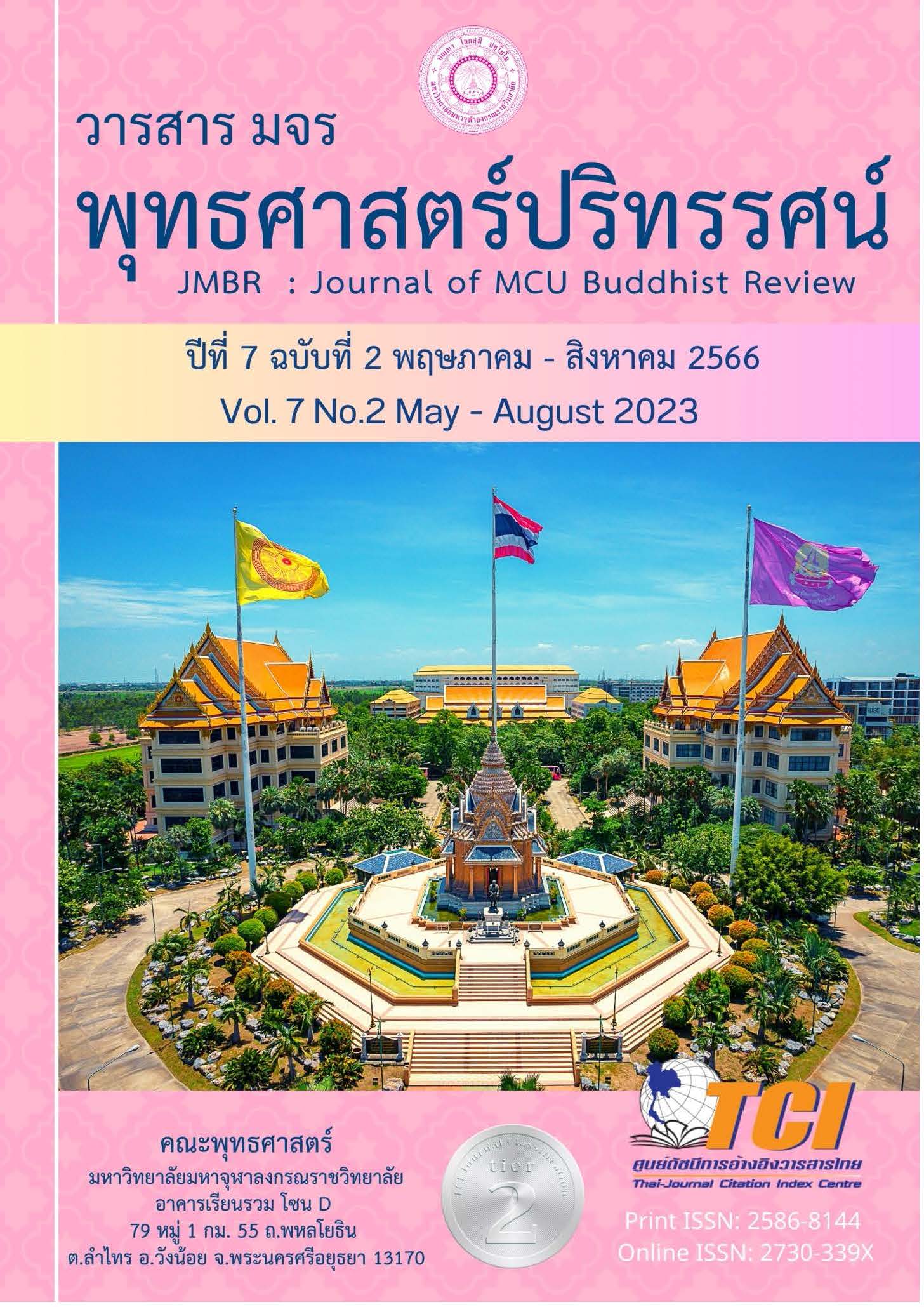กฤตในคัมภีร์ลฆุสิทธานตเกามุทีและกิตก์ในคัมภีร์ปทรูปสิทธิ: การศึกษาเปรียบเทียบ
Main Article Content
บทคัดย่อ
บทความวิจัยนี้มีวัตถุประสงค์ 1) เพื่อศึกษาประวัติความเป็นมาของคัมภีร์ลฆุสิทธานตเกามุที และปทรูปสิทธิ 2) เพื่อแปลกฤทันตะปกรณ์ในคัมภีร์ลฆุสิทธานตเกามุที และกิพพิธานกัณฑ์ในคัมภีร์ปทรูปสิทธิ และ 3) เพื่อศึกษาเปรียบเทียบกฤตในคัมภีร์ลฆุสิทธานตเกามุที และกิตก์ในคัมภีร์ปทรูปสิทธิ เป็นการวิจัยเชิงคุณภาพโดยใช้กระบวนการวิจัยเชิงปฏิบัติการมาเป็นส่วนหนึ่งของการดําเนินการวิจัย เน้นการศึกษา วิเคราะห์ทั้งในเชิงพื้นที่และกลุ่มเป้าหมาย มีการจัดกระบวนการวิจัยด้วยการถอดบทเรียนและการบูรณาการ ข้อมูลที่ได้จากการสัมภาษณ์ การสังเกต และการปฏิบัติการร่วมกันในพื้นที่ศึกษาและกลุ่มเป้าหมายที่กําหนดไว้โดยใช้กระบวนการตามวงจรเดมมิง เป็นเครื่องมือในการดําเนินงานการวิจัยเชิงปฏิบัติการแบบมีส่วนร่วมในทุกขั้นตอน
ผลการวิจัยพบว่า 1) คัมภีร์ลฆุสิทธานตเกามุทีแต่งโดยวรทราชในราวพุทธศตวรรษที่ 11 (คริสต์ศตวรรษที่ 17) ส่วนคัมภีร์ปทรูปสิทธิแต่งโดยพระพุทธัปปิยะ ในราวปลายพุทธศตวรรษที่ 15 ถึงต้นพุทธศตวรรษที่ 16 คัมภีร์ลฆุสิทธานตเกามุทีเป็นคัมภีร์ที่ได้นำสูตรจากคัมภีร์สิทธานตเกามุทีอันเป็นคัมภีร์ ที่ปรับปรุงลำดับสูตรในคัมภีร์อัษฎาธยายีของปาณินิมาเรียบเรียงใหม่ตามลำดับ ทำให้เข้าใจได้ง่ายขึ้น ส่วนคัมภีร์ปทรูปสิทธิเป็นคัมภีร์ที่ได้นำเอาสูตรมาจากคัมภีร์กัจจายนะมาเรียงลำดับใหม่ แต่งอธิบายเพิ่มเติม และได้นำอุทาหรณ์มาจากคัมภีร์ต่าง ๆ ส่วนใหญ่มาจากพระไตรปิฎก 2) คำว่ากฤต และกิตก์ ใช้ในความหมายเดียวกัน คือ การนำปัจจัยมาประกอบกับธาตุซึ่งเป็นความดั้งเดิม แล้วได้ความหมายไปในรูปแบบเป็นนามบ้าง กิริยาบ้าง 3) คัมภีร์ลฆุสิทธานตเกามุทีได้จัดหมวดหมู่ของ กฤต ตามปัจจัย เป็น 2 คือ 1.กฤตยปัจจัย 2.กฤตปัจจัย คัมภีร์ปทรูปสิทธิได้จัดหมวดหมู่ของ กิตก์ ตามกาลและปัจจัย เป็น 6 คือ 1.กิจจปัจจัย กิตกปัจจัย รวม 2 หมวดนี้ จัดเป็นเตกาลิกปัจจัยที่เป็นได้ทั้ง 3 กาล คือ อดีต ปัจจุบัน และอนาคต 2.อตีตปัจจัย 3.ตเวตุนาทิปัจจัย 4.วัตตมานกาลิกมานันตปัจจัย 5.อนาคตกาลิกปัจจัย 6.อุณาทิ ปัจจัย ในคัมภีร์ลฆุสิทธานตเกามุทีใช้สูตรทั้งหมด 129 สูตร ในการอธิบายกฤทันตะ (กฤต)ส่วนในคัมภีร์ปทรูปสิทธิใช้สูตรทั้งหมด 140 สูตร ในการอธิบายกิพพิธาน (วิธีของกิตก์) การวางโครงสร้างการแต่งเหมือนกันทั้งสองคัมภีร์ คือ สูตร วฤติ,วุตติ และ อุทาหรณ์ การเขียนสูตรใช้หลักการเดียวกัน คือ กะทัดรัดคลอบคลุมความหมายได้มากเนื้อหาโดยรวม สูตรลฆุสิทธานตเกามุทีที่เปรียบเทียบได้ มี 67 สูตร ที่เปรียบเทียบไม่ได้มี 62 สูตร
Article Details

อนุญาตภายใต้เงื่อนไข Creative Commons Attribution-NonCommercial-NoDerivatives 4.0 International License.
- บทความที่ได้รับการตีพิมพ์เป็นลิขสิทธิ์ของวารสาร มจร พุทธศาสตร์ปริทรรศน์
- ข้อความใดๆ ที่ปรากฎในบทความที่ได้รับการตีพิมพ์ในวารสาร ถือเป็นความรับผิดชอบของผู้เขียนบทความ และข้อคิดเห็นนั้นไม่ถือว่าเป็นทัศนะและความรับผิดชอบของกองบรรณาธิการวารสาร มจร พุทธศาสตร์ปริทรรศน์
เอกสารอ้างอิง
จิรพัฒน์ ประพันธ์วิทยา. (2522). อิทธิพลของภาษาบาลีและสันสกฤตที่มีต่อภาษาไทย. เชียงใหม่: คณะมนุษยศาสตร์ มหาวิทยาลัยเชียงใหม่.
พระมหาโกมล แก้วดึง. (2548). การศึกษาเปรียบเทียบคำนามในคัมภีร์ปทรูปสิทธิและลฆุสิทธานตเกามุที. วิทยานิพนธ์ศิลปศาสตรมหาบัณฑิต บัณฑิตวิทยาลัย: มหาวิทยาลัยศิลปากร.
พระมหาวาสนา กลฺยาโณ. (2550). การศึกษาเรื่องการกในคัมภีร์โมคคัลลานไวยากรณ์. วิทยานิพนธ์พุทธศาสตรมหาบัณฑิต บัณฑิตวิทยาลัย: มหาวิทยาลัยมหาจุฬาลงกรณราชวิทยาลัย.
พระมหาสมปอง มุทิโต. (2547). ปทรูปสิทธิ. กรุงเทพฯ: บริษัท ธนาเพรส แอนด์ กราฟฟิค จำกัด.
พระมหาเสฐียรพงษ์ ปุณฺณวณฺโณ. (2514). วรรณ์ ไวทยากรณ์ ภาษาศาสตร์ โครงการตำราสังคมศาสตร์และ มนุษยศาสตร์. พระนคร: ไทยวัฒนาพานิช.
พระมหาชิต านชิโต. (2560). คัมภีร์ลฆุเกามุที: ปริวรรต แปลความและการศึกษาวิเคราะห์. นครปฐม: วิทยา
เขตบาฬีศึกษาพุทธโฆส มหาวิทยาลัยมหาจุฬาลงกรณราชวิทยาลัย
Ballantyne, J.R. (1891). Laghukaumudī of Varadarāja. Fourth Edition: Varanasi.
Ghosh, B. (1937). Introduction to Linguistic Sanskrit. Calcutta: Arunima Printing Works.
Raghavan. H. (1961). sanskrit Literature. Delhi: Government of India Press.


